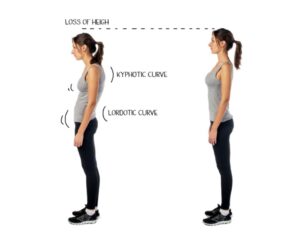Posture – It Matters
Posted on 2nd December 2013 | by steve
If there was a simple way to look taller, slimmer and improve your general health would you be interested?
Well there is. It’s called “having healthy posture”, and as our bodies are moulded from a young age by the way we sit, stand, sleep and move there are lots of good reasons to be mindful of our posture, and to do what we can to carry ourselves in a healthy, upright way.
The Benefits Of Good Posture
Good posture has many benefits. Cosmetically, you’ll look taller, slimmer, and your clothing will fit better as well, but – just as importantly – good posture also:
- Helps you to move more easily, with greater speed, strength, endurance and efficiency
- Reduces the wear and tear on your spine, discs and other structures of your musculoskeletal framework.
- Aids proper breathing and digestion
- Helps to reduce feelings of stress and fatigue, and
- Can improve feelings of self confidence and general wellbeing.
The Consequences Of Poor Posture 
In contrast, poor posture:
- Increases the stress placed on your spine and musculoskeletal framework, predisposing these structures to premature wear and tear and damage.
- Increases your susceptibility to conditions such as postural tension, back and neck pain, headaches, and lower limb joint problems.
- Restricts your ability to breathe properly (breathing capacity can be diminished by as much as 30%)
- Can cause digestive difficulties as a result of compression and impaired function of internal organs, and
- Predisposes you to feelings of fatigue – it takes a lot of energy to hold the body in an awkward position for sustained periods of time.
Common Postural Traps
Modern lifestyles are full of activities that that reinforce poor postural habits. The single biggest culprit is the amount of time we spend sitting, but other “postural traps” to be wary of include:
- Being a gadget lover – Ipads and smart phones are great tools, but how much time are you spending hunched over that little screen, even when you’re out and about and on the move?
- Lack of exercise – do you exercise? If so, great, but make sure you’re not doing the same thing over and over and inadvertently creating postural imbalances in your body.
- How do you carry your handbag, your computer, your suitcase or other heavy objects? Are you always using one side of your body more than the other? Can you balance the workload across both sides of your body a bit more evenly?
- How do you sleep? Make sure you don’t sleep on your stomach, and that you’ve got a supportive mattress and pillow.
- Do you sit on your wallet? If so, you may be causing a pelvic imbalance, so try putting it somewhere else instead.
- How do you relax at home? Sofas often look great, but they usually offer very little support to your spine and can be murder on your body, so much so that you’re often better off lying on sofas rather than sitting on them.
Making Change
Correcting poor posture doesn’t happen overnight, and some kinds of postural imbalance are resistant to change, but in most cases improved postural awareness coupled with simple changes in how you use your body can make a real difference over time and the benefits are well worth the effort.
The younger we are when we start looking after our bodies the better, so check out our other articles on common postural issues for further tips and suggestions that will help you to look, feel and function at your best.

